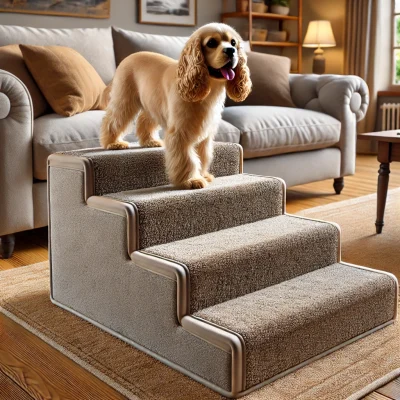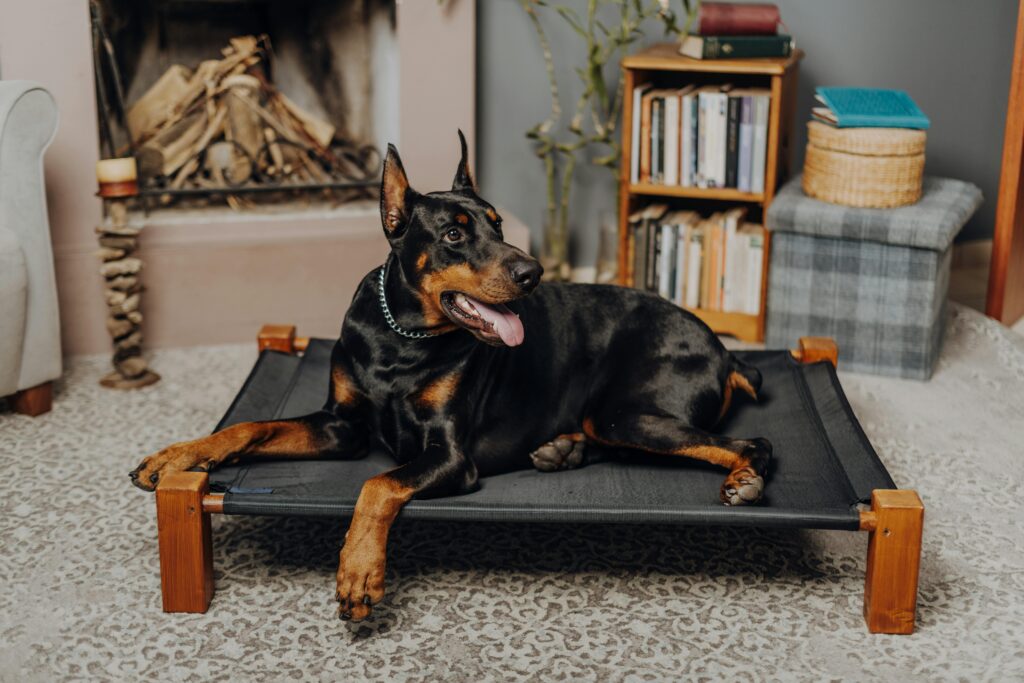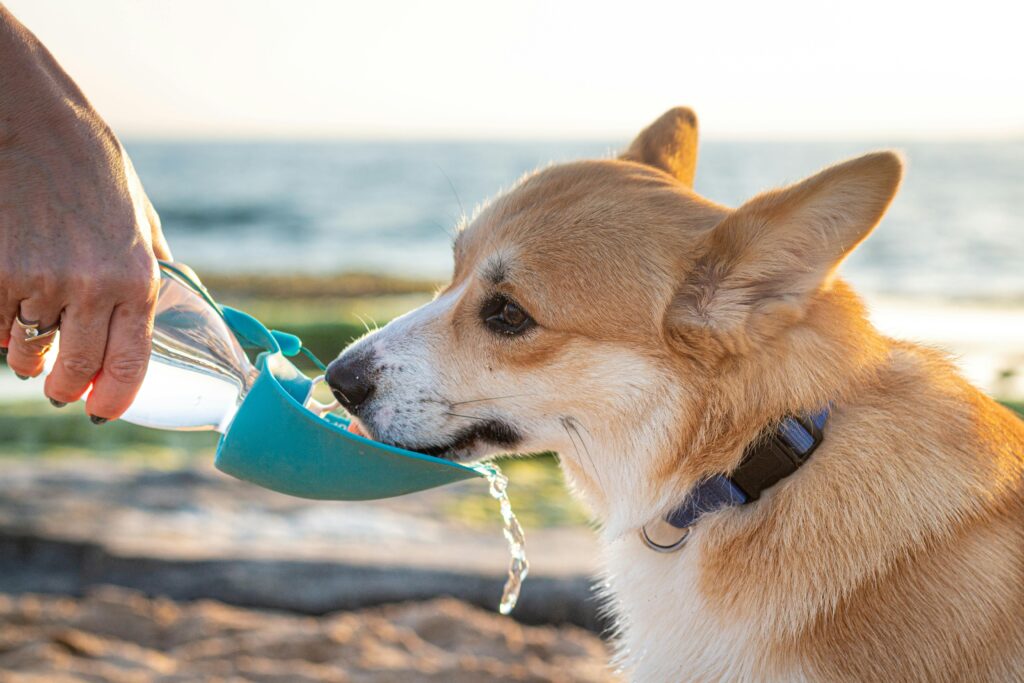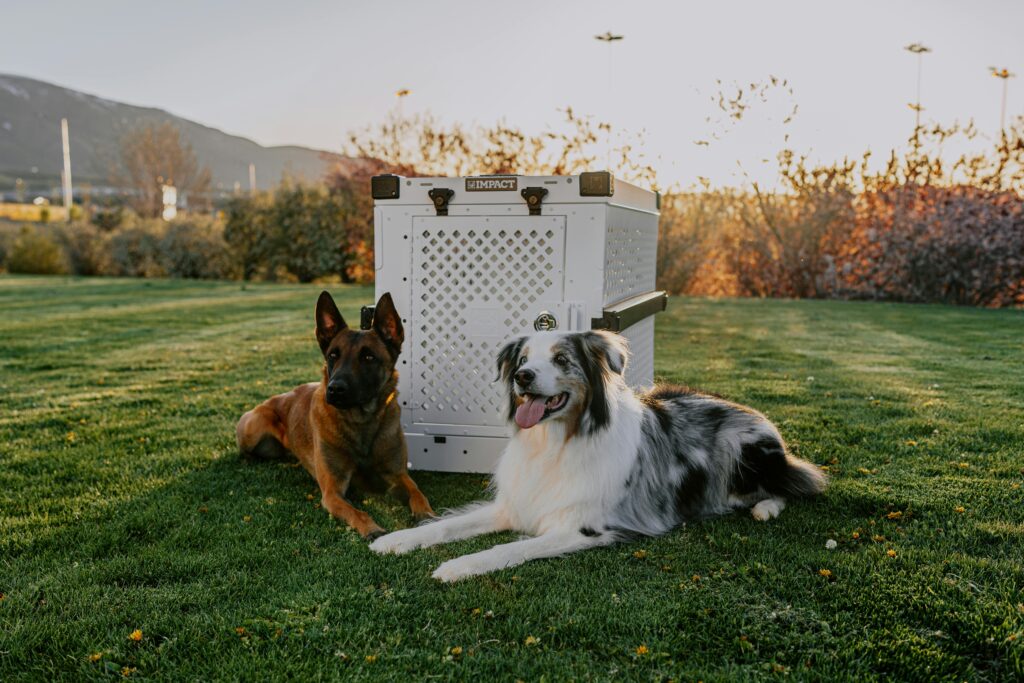The Ultimate Guide to Dog Stairs for bed: Helping Your Pet Reach New Heights

Dog stairs for bed are essential tools for pet owners who want to provide their dogs with a safe and comfortable way to reach higher surfaces, such as beds, couches, or cars. These products are especially beneficial for small, elderly, or injured dogs who have difficulty jumping. In this comprehensive guide, we’ll explore everything you need to know about dog stairs and steps, including their benefits, types, buying factors, maintenance tips, and the most popular products on Amazon.
1. What Are Dog Stairs & Steps?
Dog stairs and steps are specially designed platforms that allow dogs to reach elevated surfaces such as couches, beds, or cars. They come in various sizes, shapes, and materials to accommodate different dog breeds and home settings. While dog stairs typically feature multiple small steps, dog ramps are often used interchangeably with stairs when discussing pet accessibility solutions. However, ramps are inclined planes, whereas stairs consist of separate steps.
2. Benefits of Using Dog Stairs & Steps
Joint Health and Injury Prevention
Jumping up onto furniture or into a vehicle can put stress on a dog’s joints, especially in breeds prone to hip dysplasia or arthritis. Dog stairs provide a gentle, gradual incline that reduces the risk of injury and helps to protect the joints from wear and tear.
Accessibility for Small and Senior Dogs
Dog stairs and steps are particularly beneficial for small breeds, elderly dogs, or pets with mobility issues. These dogs often struggle to reach elevated surfaces and may avoid jumping due to discomfort. Stairs provide a safer, more accessible option, allowing them to maintain their independence.
Post-Surgery Recovery
After surgery, dogs may have restricted movement or difficulty jumping. Dog stairs provide a safe and supportive way for pets to get up onto the bed, couch, or car without straining their healing joints or muscles.
Versatility
Dog stairs are versatile and can be used in various locations, such as next to a bed, couch, or even in the car. Many models are lightweight and portable, making them ideal for travel or use in different areas of the home.
3. Different Types of Dog Stairs & Steps
Foam Steps
Foam dog stairs are lightweight and easy to move, making them suitable for smaller dogs or dogs with joint issues. The foam material provides a soft landing, which can be gentler on a dog’s paws and joints. These stairs are usually covered with a removable fabric that is machine washable.
Wooden Stairs
Wooden dog stairs are more durable and offer a sturdy structure that can support larger dogs. They often come with non-slip treads on each step to provide better traction. Wooden stairs are ideal for pets who need a solid, stable platform for support.
Plastic Stairs
Plastic dog stairs are lightweight and easy to clean, making them suitable for indoor and outdoor use. They are often designed with non-slip steps or carpeted surfaces to prevent dogs from slipping. Plastic stairs are typically foldable, making them portable and convenient for travel.
Foldable or Portable Stairs
Foldable dog stairs are designed for portability and ease of storage. These stairs can be folded up and stored when not in use, making them a great option for pet owners who travel frequently or have limited space in their homes.
4. Factors to Consider When Buying Dog Stairs & Steps
Size and Weight Capacity
Ensure that the dog stairs are the appropriate size for your pet. The steps should be wide and deep enough for your dog to climb comfortably, and the height should be suitable for reaching the intended surface. Additionally, check the weight capacity to ensure it can support your dog’s weight.
Material
Choose a material that is durable and suitable for your dog’s needs. Foam steps are lightweight and comfortable, while wooden stairs offer more stability. Plastic stairs are great for easy cleaning and portability.
Number of Steps
The number of steps should be appropriate for the height of the surface you want your dog to reach. More steps may be needed for taller furniture to provide a gradual incline.
Traction and Safety Features
Look for dog stairs with non-slip surfaces or textured treads to ensure your dog has a secure footing. Safety rails on the sides can also provide additional support for dogs with mobility issues.
Portability
If you plan to use the stairs in multiple locations or take them on trips, opt for lightweight, foldable stairs that are easy to transport and store.
5. How to Train Your Dog to Use Stairs & Steps
Training your dog to use stairs can take some patience, but with consistent practice, most dogs will learn quickly:
- Place treats on each step to encourage your dog to climb up.
- Use a leash to guide your dog up and down the stairs.
- Reward with treats and praise each time your dog uses the stairs.
- Repeat the training regularly until your dog feels comfortable using the stairs without hesitation.
6. Maintenance Tips for Dog Stairs & Steps
Keeping your dog stairs clean and well-maintained will help ensure their longevity:
- Vacuum foam or fabric stairs to remove pet hair and dirt.
- Wipe plastic or wooden stairs with a damp cloth.
- Check for wear and tear regularly and replace any worn treads or covers.
- Ensure that the stairs remain stable and are not placed on slippery surfaces.
Also Read

Apparel & Accessories

Beds & Furniture

Cameras & Monitors
Blink 2, bLINK OUTDOOR 4, Kasa Indoor, WYZE cam V4, Furbo, Pet Cube, Tapo, Hugolog, eufy, WOPET.

Travel Products
7. Most-Selling Dog Stairs & Steps on Amazon
Here are some of the most popular dog stairs and steps available on Amazon, including their features, pros, cons, and price range:
a. PetSafe CozyUp Folding Pet Steps
- Features: Lightweight, foldable, and available in two sizes. Comes with non-slip feet and fabric tread covers for added traction.
- Pros: Easy to store, suitable for small to medium-sized dogs, affordable.
- Cons: Not sturdy enough for very large dogs.
- Price: Approximately $30 – $50.
b. Zinus Step Comfort Pet Stairs
- Features: Made with high-density foam, covered in soft fabric, and available in multiple sizes and colors.
- Pros: Gentle on joints, removable and washable cover, comfortable for small dogs.
- Cons: May not be suitable for larger dogs due to foam structure.
- Price: Around $35 – $80.
c. Pet Gear Easy Step II Pet Stairs
- Features: Designed with wide, deep steps for smaller or older dogs. Features carpeted tread for added traction and side rails for extra safety.
- Pros: Sturdy, easy to assemble, great for older pets.
- Cons: Carpet treads may need regular cleaning.
- Price: Typically $40 – $70.
d. Solvit PupSTEP Plus Pet Stairs
- Features: Durable plastic construction with non-slip tread covers and foldable design. Suitable for pets up to 150 pounds.
- Pros: Lightweight and portable, easy to clean, supports larger dogs.
- Cons: Steps may be too narrow for some larger dogs.
- Price: Around $30 – $60.
e. Petsfit Wooden Pet Stairs
- Features: Made from sturdy wood, includes non-slip treads and safety rails. Foldable for easy storage.
- Pros: Durable and stable, attractive design, suitable for large dogs.
- Cons: Heavier than foam or plastic stairs.
- Price: Approximately $60 – $120.
8. DIY Dog Stairs & Steps: How to Make Them at Home
If you’re handy with tools, you can create a set of dog stairs at home. Here’s how:
Materials Needed:
- Plywood or wooden boards
- Saw and screws
- Carpet for traction
- Measuring tape
- Sandpaper
Steps:
- Measure and cut the wood according to the desired height and number of steps.
- Assemble the frame using screws to secure the steps in place.
- Sand down any rough edges to prevent splinters.
- Attach the carpet to the top of each step for added traction.
- Stain or paint the wood to match your decor.
9. Conclusion
Dog stairs and steps provide a practical solution for pets who struggle with jumping due to age, size, or joint issues. These products not only enhance your dog’s safety but also contribute to their overall well-being by reducing the risk of injury. Whether you choose foam, wooden, plastic, or foldable stairs, it’s important to consider your dog’s specific needs when making a purchase.
Check out the top-selling products on Amazon for high-quality options that suit various requirements. With the right dog stairs, your furry friend can enjoy greater independence and mobility.
FAQ
The choice between dog stairs and ramps depends on your dog’s needs. Ramps are better for dogs with severe mobility issues, arthritis, or joint problems because they provide a smooth, gradual incline. Dog stairs are suitable for dogs with minor mobility issues or for small breeds that need help reaching elevated surfaces. Stairs take up less space and can be a better fit for homes with limited room.
To choose the right size, measure the height of the surface your dog needs to reach (e.g., bed, couch, car). The stairs should be tall enough to allow your dog to climb comfortably without straining. Also, consider the step depth and width; the steps should be wide enough for your dog to step on easily.
Yes, dog stairs are very helpful for older dogs, especially those with arthritis or joint issues. Stairs provide a gentle incline that reduces the need to jump, thereby minimizing stress on the joints and preventing further discomfort or injury.
Yes, using dog stairs can reduce the impact on your dog’s joints by allowing them to climb up and down gradually rather than jumping. This can help prevent joint problems, particularly in breeds prone to hip dysplasia or arthritis.
The best materials depend on your dog’s size and needs:
- Foam stairs: Ideal for small dogs or those with joint issues, as they are lightweight and gentle on the paws.
- Wooden stairs: Sturdy and suitable for larger dogs, offering a solid structure.
- Plastic stairs: Lightweight, easy to clean, and great for both indoor and outdoor use.
The number of steps depends on the height of your bed. For beds that are 20-30 inches high, dog stairs with 3-5 steps are typically suitable. The goal is to have each step be around 4-8 inches tall for a gradual climb.
Foam dog stairs are durable for small to medium-sized dogs but may not be suitable for large breeds due to their softer structure. High-density foam is more durable and can provide better support, but it’s still less sturdy than wood or plastic stairs.
Training your dog to use stairs involves:
- Placing treats on each step to encourage your dog to climb.
- Using a leash to guide your dog up and down.
- Praising and rewarding your dog each time they use the stairs successfully.
- Practicing consistently until your dog becomes comfortable.
Yes, dog stairs can be used for cars and SUVs, provided they are tall enough to reach the vehicle’s height. Look for foldable or portable dog stairs that are specifically designed for outdoor use and can support your dog’s weight.
Yes, dog stairs are safe for small breeds. They help small dogs reach higher surfaces without having to jump, reducing the risk of injury. Make sure the steps are not too steep and are wide enough for your dog to climb comfortably.
Many foam dog stairs come with removable fabric covers that can be machine washed. Wooden or plastic stairs may have removable carpeted treads for easy cleaning. Check the product description to ensure the stairs you choose have removable covers if easy cleaning is a priority.
The weight capacity varies by material:
- Foam stairs typically support up to 50-60 pounds.
- Wooden stairs can support 100 pounds or more.
- Plastic stairs can usually hold around 150 pounds, depending on the model. Always check the manufacturer’s specifications.
Plastic or foldable dog stairs are suitable for outdoor use because they are easy to clean and resistant to weather conditions. Wooden stairs can be used outside but may require treatment to prevent damage from moisture.
Foldable dog stairs can be sturdy if they are made from high-quality materials and designed to lock securely in place. However, for larger dogs, traditional wooden or fixed plastic stairs may provide more stability.
Yes, dog stairs can significantly help dogs with arthritis by reducing the impact on their joints when climbing onto furniture or getting in and out of vehicles. The stairs provide a more manageable way for them to access elevated areas without putting excessive strain on their joints.
The cost of dog stairs varies depending on the material and features:
- Foam stairs: $30 – $80
- Plastic stairs: $25 – $60
- Wooden stairs: $50 – $150
- Portable or foldable stairs: $30 – $100 Prices may be higher for stairs with premium features, such as extra-wide steps or high-density foam.
To make DIY dog stairs:
- Use plywood or wood planks for the frame and steps.
- Cut the wood to size according to the desired height and number of steps.
- Assemble the frame using screws and nails.
- Attach carpeting or anti-slip material to each step for traction.
- Paint or stain the wood to match your decor.
For large breeds, choose dog stairs that are made from sturdy materials like wood or heavy-duty plastic. The steps should be wide and deep enough to support a larger dog, and the weight capacity should be at least 100 pounds. Look for stairs with non-slip surfaces and safety rails.
Yes, puppies can use dog stairs safely if the steps are appropriately sized and not too steep. Supervise young puppies to ensure they climb up and down safely, and choose stairs with soft, cushioned steps to prevent injury.
To prevent dog stairs from sliding, use a non-slip mat or rubber pads under the stairs. Some stairs come with non-skid feet or anti-slip grips that keep them securely in place. Make sure the stairs are placed on a stable surface.
Related Articles

Collars & Harnesses

Doors, Gates & Ramps

